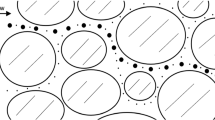Abstract
The paper examined the effects of colloid size and molar ratio of Ca2+/Na+ on the retention and release of colloids under transients in ionic strength (IS). Column experiments were conducted to elucidate the transport behavior of three-sized polystyrene latex microspheres (300 nm, 500 nm, and 1000 nm) by varied molar ratios of Ca2+/Na+. Colloid concentration breakthrough curves showed the retention of colloids enhanced with the increase of molar ratio and the decrease of colloid size, which can be explained by Derjaguin–Landau–Verwey–Overbeek theory and the existence of nanoscale surface roughness. When the IS of the eluting solution was reduced from 10 to 1 mM, and when the eluting solution changed to ultrapure water, peak concentrations of colloid release were observed. Colloid recovery rates during the injection of ultrapure water were low, and substantial proportion of colloid still retained in the column even after the injection of ultrapure water, which suggested a stronger influence caused by the primary minimum compared with the secondary minimum on the retention of colloid. A modified numerical model considering the processes of Langmuirian dynamics blocking associated with a conservative tracer equation was successfully developed to simulate the transport process of all the experiments.




Similar content being viewed by others
References
Bradford SA, Torkzaban S (2008) Colloid transport and retention in unsaturated porous media: a review of interface-, collector-, and pore-scale processes and models. Vadose Zone J 7(2):667–681
Bradford SA, Yates SR, Bettahar M et al (2002) Physical factors affecting the transport and fate of colloids in saturated porous media. Water Resources Research 38(12):63-1–63-12
Bradford SA, Torkzaban S, Leij F et al (2015) Equilibrium and kinetic models for colloid release under transient solution chemistry conditions. J Contam Hydrol 181:141
Cai L, Zhu J, Hou Y et al (2015) Influence of gravity on transport and retention of representative engineered nanoparticles in quartz sand. J Contam Hydrol 181:153
Fan W, Jiang XH, Yang W, Geng Z, Huo MX, Liu ZM, Zhou H (2015) Transport of graphene oxide in saturated porous media: effect of cation composition in mixed Na-Ca electrolyte systems. Sci Total Environ 511:509–515
Gregory J (1981) Approximate expressions for retarded van der Waals interaction. J Colloid Interface Sci 83(1):138–145
Grolimund D, Borkovec M (2005) Colloid-facilitated transport of strongly sorbing contaminants in natural porous media: mathematical modeling and laboratory column experiments. Environ Sci Technol 39(17):6378–6386
Hahn MW, Abadzic D, O’Melia CR (2004) Aquasols: on the role of secondary minima. Environ Sci Technol 38(22):5915
Hogg R, Healy TW, Fuerstenau DW (1966) Mutual coagulation of colloidal dispersions. Trans Faraday Soc 62:1638–1651
Ko CH, Elimelech M (2000) The “shadow effect” in colloid transport and deposition dynamics in granular porous media: measurements and mechanisms. Environ Sci Technol 34(17):3681–3689
Loveland JP, Ryan JN, Amy GL et al (1996) The reversibility of virus attachment to mineral surfaces. Colloids Surf A Physicochem Eng Asp 107(4):205–221
May R, Li Y (2013) The effects of particle size on the deposition of fluorescent nanoparticles in porous media: direct observation using laser scanning cytometry. Colloids Surf A Physicochem Eng Asp 418(5):84–91
Moussa AB, Mzali H, Zouari K et al (2014) Hydrochemical and isotopic assessment of groundwater quality in the Quaternary shallow aquifer, Tazoghrane region, north-eastern Tunisia. Quat Int 338(4):51–58
Qi Z, Zhang L, Wang F et al (2014) Factors controlling transport of graphene oxide nanoparticles in saturated sand columns. Environ Toxicol Chem 33(5):998
Shen C, Wang L, Li B, Huang Y, Jin Y (2012) Role of surface roughness in chemical detachment of colloids deposited at primary energy minima. Vadose Zone J 11:59-75.
Torkzaban S, Bradford SA (2016) Critical role of surface roughness on colloid retention and release in porous media. Water Res 88:274
Torkzaban S, Bradford SA, van Genuchten MT et al (2008) Colloid transport in unsaturated porous media: the role of water content and ionic strength on particle straining. J Contam Hydrol 96(1–4):113–127
Torkzaban S, Kim HN, Simunek J, Bradford SA (2010) Hysteresis of colloid retention and release in saturated porous media during transients in solution chemistry. Environ Sci Technol 44(5):1662–1669
Tosco T, Tiraferri A, Sethi R (2009) Ionic strength dependent transport of microparticles in saturated porous media: modeling mobilization and immobilization phenomena under transient chemical conditions. Environ Sci Technol 43(12):4425–4431
Zhang Q, Raoof A, Hassanizadeh SM (2015) Pore-scale study of flow rate on colloid attachment and remobilization in a saturated micromodel. J Environ Qual 44(5):1376–1383
Acknowledgments
We express our sincere appreciation for the help of key laboratory of groundwater remediation (Institute of hydrogeology and environmental geology, Chinese Academy of Geological Sciences).
Funding
This work is supported by the National Natural Science Foundation of China Youth Fund (no. 41502228).
Author information
Authors and Affiliations
Corresponding author
Additional information
Responsible Editor: Mehmet Sabri Celik
Rights and permissions
About this article
Cite this article
Zhang, Q., Yu, Y. & Cui, Y. The role of particle size and molar ratio of Ca2+/Na+ in the retention and remobilization of colloids in saturated porous media. Arab J Geosci 13, 273 (2020). https://doi.org/10.1007/s12517-020-5220-4
Received:
Accepted:
Published:
DOI: https://doi.org/10.1007/s12517-020-5220-4




